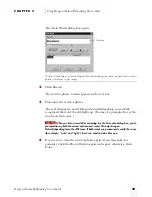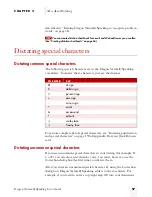
C H A P T E R 3
More About Dictating
Dragon NaturallySpeaking User’s Guide
50
■
Breathe deeply from your abdomen and not from the top of your
chest.
■
Loosen up and relax: stretch your arms, shoulders, neck, and jaw
muscles.
■
Take occasional breaks: get up, move around, and stretch.
■
Keep your vocal cords moist: take sips of water and use a straw so
you don’t have to move the microphone out of place.
Dictating names of people,
places, and events
Many names of people, places, and events are already in the Dragon
NaturallySpeaking vocabulary. For example, you can dictate “Michael
Jordan,” “Newton, Massachusetts,” and “Disneyland.” Your first step should
always be to try dictating the name.
To dictate names:
Dictate your name and your hometown. For example, say “My name is
Louise O’Toole [period] My hometown is Newton [comma] Massachusetts
[period]”
Say the words as clearly as possible. (Dragon NaturallySpeaking
automatically capitalizes the names it knows, so you don’t have to say
“Cap.”)
Did Dragon NaturallySpeaking get your name and hometown correct? If
not, it may mean that your name, hometown, or both aren’t in the
vocabulary. Not all proper names are in the vocabulary, but you can
easily add them by using the Correction dialog box (as described in
“Correcting recognition mistakes” on page 13).
When you add a word to the vocabulary, Dragon NaturallySpeaking
automatically “guesses” its pronunciation based on how it’s spelled. If the word is not
recognized when you say it, you should train Dragon NaturallySpeaking to recognize it
(as described in “Training Dragon NaturallySpeaking to recognize problem words” on
page 38).
When you dictate a name that can be spelled more than one way (for
example, “John” or “Jon”), Dragon NaturallySpeaking types the most
NOTE
ugpro.bk Page 50 Monday, August 9, 1999 9:42 AM
















































